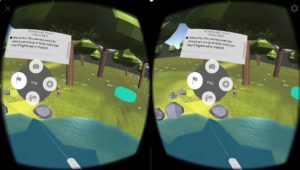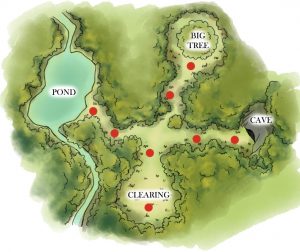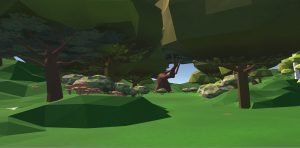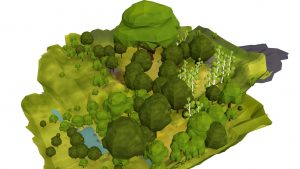Week 8
All is busy in the Team Voyage project room as most of our time is spent preparing for halves presentations. We have a lot to show and are still trying to tackle how to present it.
Two of our major steps forward this week have been the integration of the scavenger hunt into our experience as well as completing the rough spring landscape.
Starting with the scavenger hunt, here is our current setup: we already have 3 pre-set teams of 6 to 7 students based on their names. The students can tell what team they are on by clicking on the menu button, and looking near the top of their menu UI. It will say clearly, for example, “ Scavenger Hunt: Team Red,” along with the red team’s hint (obviously showing that this student is on the red team).

(Sorry for the poor quality image, but the text near the top tells the different team names)
Students will be able to identify others on their team by the color of their scarves(red scarf = red team, yellow scarf = yellow team, etc.).
(notice the different color scarves!)
The three teams each have a different set of things to find that are placed strategically around the map, so that each team needs to explore all parts of the environment to finish their particular scavenger hunt. The scavenger hunt clues are given one by one, meaning that you need to solve the first hint in order to get the next hint. The current iteration of the clues look like this:
Team 1:
- Find three tertiary consumers (apex predators)(answers would be the bear, wolf and hawk).
- Find: “This nervous and shy animal can run up to forty miles per hour if frightened or chased.” (The white tailed deer).
- Find the tree which produces leaves with a single vien, no lobes, and jagged edges. (Birch Tree).
Team 2:
- Find 5 producers (Oak Tree, Birch Tree, Honeysuckle, Lilac, Ladyfern, Milkweed, or Maple tree).
- Find: “This mainly nocturnal animal is at the top of the food chain in the forest with no natural predators. Hating the heat of the sun, they will be seen digging ot their dens in the shade” (Gray Wolf).
- Find the tree that produces samaras (Maple Tree).
Team 3:
- Find two primary consumers (caterpillar, butterfly, or white tailed deer) and one decomposer (tawny milkcap mushroom).
- Find: “waking up from a very long nap, this omnivorous animal forages for an plants of animals it can find to snack on close to it’s napping spot. (Black Bear)
- Find the tree that produces acorns. (Oak Tree)
When a student thinks they’re found the correct object in the environment, they can use our “flag” tool to mark that object. If they are correct, a diamond in the same color as the student that found it’s team will appear and hover above that object for the whole class to see.
A question came up about what is the purpose of the scavenger hunt in our experience. It solves two problems. 1. The group activity will initiate collaboration. They need to work together or at least communicate with their team in order to solve the scavenger hunt (this type of collaboration is the point of our project). 2. It will increase the learnings of the students. In order to solve the hunts, they need to read the information on the blurbs and use their problem solving skills to solidify the info they learned.
Now we need to playtest this! We have many questions. Will the design of the hunt make sense to the students? Is the distribution of hunt clues fair? Will they feel competitive/collaborative with each other? Will they learn anything? Only the future can tell!
Moving to the environment, we are quite excited to have the full spring environment first draft. We started with this top view

And now, after implementing all of our models in Maya, we have these:


It feels quite satisfying to teleport around the environment.
Lastly, we were also able to have a small playtest with a touring group at the ETC (kids in 7th grade). We noticed that the energy in the room about our project was a lot less than it is at Cornell. Nicky had some really interesting thoughts as to why. She thought that kids weren’t as excited to play when its not their own name that they are picking when choosing avatars. The default names we’ve inputted were the ones of the Cornell students and since we were given such short time, we didn’t implement these kids names instead. Also, they are unable to identify their friends because of the same reason. A lot of “whos Jim?” or “whos Jake?” reverberated around the room. Also, there was no waving at other players in the space amongst these kids; a telltale sign of the lack of connection. Waving was extremely prevalent in the other playtests at Cornell. The lack of interest could have stemmed from the idea that people wanted to connect with and identify their friends in the space. There’s a general assumption that people might want to take on a completely new persona in VR, but that might not entirely be the case.
It could be that or, you know, they could be shy…
Until Next Time!
